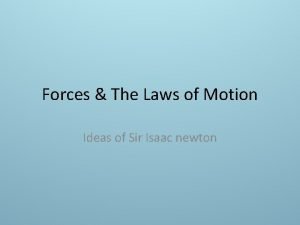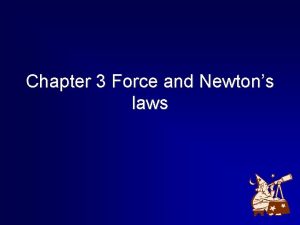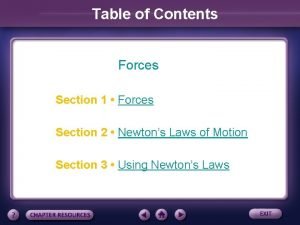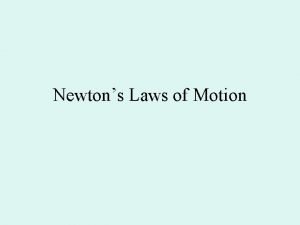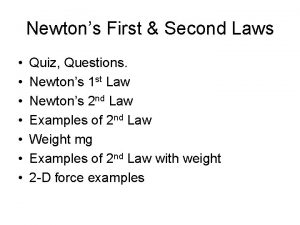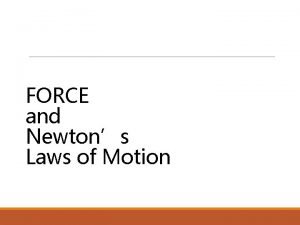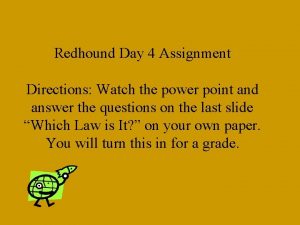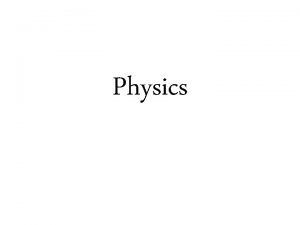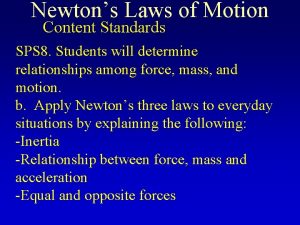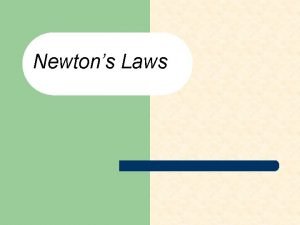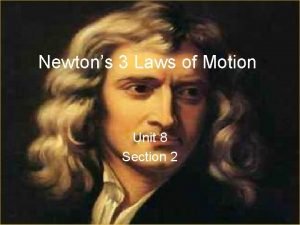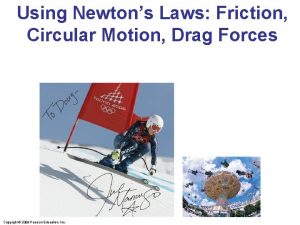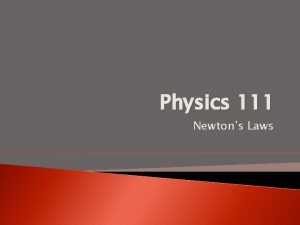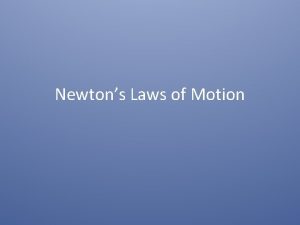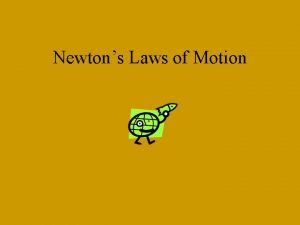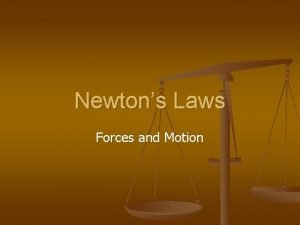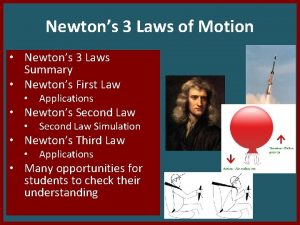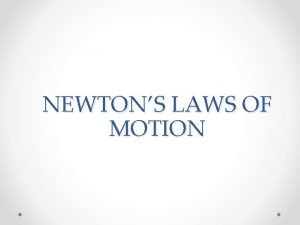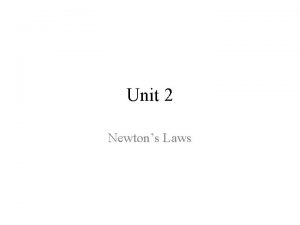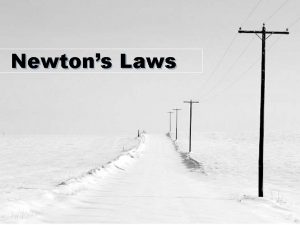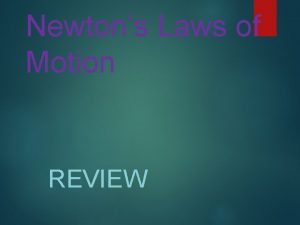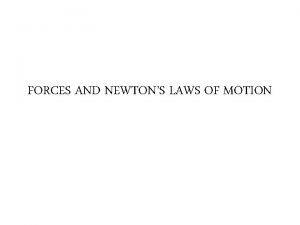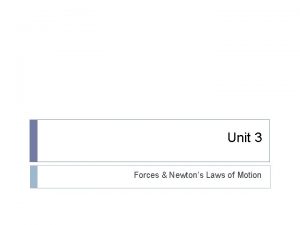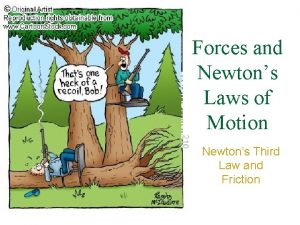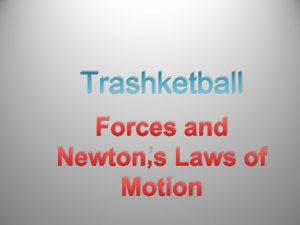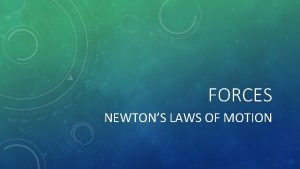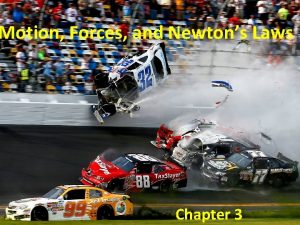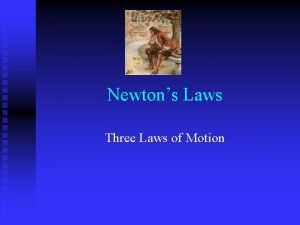Chapter 4 Forces Newtons Laws of Motion Forces
























- Slides: 24

Chapter 4: Forces & Newton’s Laws of Motion

» Forces can be thought of as pushes and pulls » Examples ˃ You exert a force on a door to open it (a push) ˃ Gravity exerts a force on you which holds you to the surface of the earth (a pull) Forces

» Forces are an interaction between two objects » You can’t touch without being touched » Examples ˃ You exert a force on a door to open it (a push) – the door pushes back on your hand ˃ Gravity exerts a force on you which holds you to the surface of the earth (a pull) – the earth is also gravitationally attracted to you Forces

» types of forces are differentiated by the way the 2 objects interact » Contact Forces – arise from the physical contact of 2 objects » Non-contact forces – two objects exert forces through a force field Forces

» When 2 object touch each other, forces perpendicular to the surfaces are called normal forces » Forces parallel to the surfaces in contact are frictional forces » Linked materials (string, rope, chain) exert tension forces on an object Contact Forces

» When an object interacts with a fluid, such as water or air, » propelling forces are called thrust, » resistive forces are called drag, » floating forces are called buoyant, » steering (or Bernoulli's) forces are called lift. Contact Forces

» When 2 objects interact without touching, they exert forces through a force field » Gravitational force » Electric force » Magnetic force Non-Contact Forces

» Newton’s First Law of Motion: The Law of Inertia » An object continues in a state of rest or in a state of motion at a constant velocity (constant speed in a constant direction) unless compelled to change that state by a net force. Newton’s First Law

The term “net force” is CRUCIAL. Often, several forces act simultaneously on a body and the net force is the vector sum of all of them. There could be say, 5 forces acting on a body and if they are exactly balanced by another 6 th force in just the right direction, the net force is zero and the object’s motion will not change. Newton’s First Law

Notice that a state of rest and a state of constant velocity are completely equal. There is no net force to change the state in either case. The purpose served when a net force acts on an object is NOT to sustain the objects velocity, but to CHANGE it. Newton’s First Law

» whenever the net force is ZERO the object's motion remains the same » if at rest, it remains at rest. » If cruising with velocity, v, it keeps on cruising with velocity, v! » Whenever the net force is NOT zero, the object's motion changes; it accelerates! Key Idea #1

» Inertia is the natural tendency of an object to remain at rest or in motion at a constant velocity. [Hence Newton’s 1 st Law being called the Law of Inertia] » The mass of an object is a quantitative measure of inertia. » The SI unit of Inertia and Mass is the kilogram (kg). Mass & Inertia

» A greater force is required to change the velocity of some objects than of others. » The larger the mass, the larger the inertia. The heavier the object, the more difficult it is to change its state of motion. Mass & Inertia

» Free-body diagrams are used to show the relative magnitude and direction of all forces acting on an object. » Note: The SI unit of force is the Newton (N) Free Body Diagrams

» In general, we will follow the following steps when creating force diagrams (free body diagrams). » 1. Sketch the system and its surroundings. » 2. Enclose the system within a system boundary. » 3. Shrink the system to a point (or a box) at the center of coordinate axes with one axis parallel to the direction of motion. » 4. Represent all relevant forces (across the system boundary) with a labeled vector. » 5. Indicate which forces (if any) are equal in magnitude to other forces. Free Body Diagrams

» Consider the analysis of forces acting on a log as a tractor pulls it at a constant speed. » Step 1. Sketch a diagram of the system and its surroundings. Example 1

» Consider the analysis of forces acting on a log as a tractor pulls it at a constant speed. » Step 2. enclose the system (log) within a closed boundary line. Example 1

» Step 3. Since the shape of the object is unimportant, shrink it to a point. Place it at the intersection of a set of coordinate axes with one of the axes parallel to the direction of motion. Example 1

» Step 4. Proceed around the system boundary line and identify all points at which there is contact between the system (log) and its surroundings. Construct qualitative vectors (indicate directions and relative magnitudes) to represent these forces. » Example 1

» Step 5: Indicate which forces (if any) are equal in magnitude to other forces. The problem states that the tractor pulls the log at constant velocity, so we know that the net force has to be zero. In other words, the forces up must equal the forces down, and the forces left must equal the forces right. In the diagram below these equalities have been marked with hashes like those used to indicate congruencies in geometry. Example 1

» Draw a free body diagram (force diagram) for a car parked on a hill. » Example 2

» Draw a free body diagram (force diagram) for a car parked on a hill. » Example 2

» Draw a free body diagram for a rock climber on a cliff. » Example 3

» Draw a free body diagram for a rock climber on a cliff. » Example 3
 Colin skateboards down the sidewalk
Colin skateboards down the sidewalk Newtons second lw
Newtons second lw 3 law of newton
3 law of newton Isaac newton laws of motion
Isaac newton laws of motion Forces and the laws of motion problem b
Forces and the laws of motion problem b Newton's laws
Newton's laws Problem 3
Problem 3 Newton's third law rockets
Newton's third law rockets Third law of newton
Third law of newton Section 3 using newtons law
Section 3 using newtons law Section 1 forces
Section 1 forces Elevator bank
Elevator bank Newtons 1 st law
Newtons 1 st law Newton's first and second law quiz
Newton's first and second law quiz Newton's 3rd law example
Newton's 3rd law example Newton's three laws
Newton's three laws Newton's all laws
Newton's all laws Newton all law
Newton all law Newton (unit)
Newton (unit) When the pellet fired into the spiral tube
When the pellet fired into the spiral tube 3 laws of newton
3 laws of newton Newton's law
Newton's law Newton's second law of circular motion
Newton's second law of circular motion Ethan is dragging a bag of grass
Ethan is dragging a bag of grass Newtons 3 rd law of motion
Newtons 3 rd law of motion




